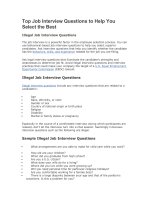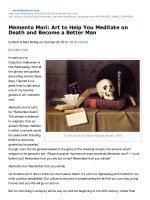Maths hacks 100 clever ways to help you understand and remember the most important theories
Bạn đang xem bản rút gọn của tài liệu. Xem và tải ngay bản đầy đủ của tài liệu tại đây (20.61 MB, 228 trang )
MATHS
HACKS
100 clever ways to help you understand
and remember the most important theories
RICH COCHRANE
Contents
Introduction
Tricks of the Trade
Numerous Numbers
The Science of Structure
Continuity
Maths in Space
Maths Meets Reality
Acknowledgements
How to Use This Ebook
Select one of the chapters from the main contents list and you will be taken straight to that chapter.
Look out for linked text (which is in blue) throughout the ebook that you can select to help you
navigate between related sections.
You can double tap images and tables to increase their size. To return to the original view, just tap
the cross in the top left-hand corner of the screen.
Introduction
Why Maths Hacks?
There is an ancient story that goes like this: King Ptolemy I of Egypt had engaged the famous geometer
Euclid as his private tutor but quickly became frustrated by the difficulty of the subject and how long
it was taking to make progress. Surely, he put it to his teacher, there is a quicker way? A shortcut? A
hack, perhaps? “There is no royal road to geometry,” Euclid replied firmly.
It probably didn’t happen quite like that, but the conversation has certainly been had countless times
since. Euclid’s answer is broadly right, and it applies not only to mathematics. Many a music student
has complained about seemingly endless hours running scales, and budding athletes have similar
grievances. Learning something hard is hard – if it wasn’t, everyone would do it.
There may not be a royal shortcut but if you are planning a road trip into mathematics there are
better and worse ways to prepare. One thing you should probably have is a map that points out the
features you might want to visit and how to get from one to another.
That is primarily what this book is: a tourist’s gazetteer of mathematics. The subject’s size and
scope can be daunting to a visitor, who is liable to get lost, especially if they don’t have even a
smattering of the local language. Like all good guidebooks, this doubles as a basic phrasebook, and it
presents an opinionated, biased and personal view. If a purely objective picture is possible, which I
doubt, you won’t find it here.
The map is not the territory, and reading this book will not make you a mathematician. It will,
though, give you a sense of what maths is and the kinds of things it studies. Almost certainly these are
quite different from your school experience, where you were probably made to do the equivalent of
memorizing the lengths of rivers and the names of capital cities: trivial, grinding, book work. Real
mathematics is more about the journey than where you arrive (nobody ever “arrives” anyway;
everyone is a student, a traveller).
When you visit a city, it’s nice to know when the cathedral was built and by whom, but only if it’s
still standing. It’s also important to know how the metro works and where the good hotels are. So,
although it contains some historical material, this book is primarily a guide to today’s field. I have
tried to ensure all major strands of contemporary pure mathematics are represented, and to include
some of the most important and dramatic results from the last century. This sometimes means covering
topics that are intrinsically “advanced” and that require more preparation than this book can
reasonably provide. This book cannot really teach you what homological algebra is, for example, but
it can tell you it exists, and roughly where it is on the map. These topics are like mountains: you will
need more than a guidebook if you intend to climb them. Here you will discover where they are and
get a hint of why you might consider a hike one day.
Parts of the Book
We start with “Tricks of the Trade”: ideas and techniques that pervade almost all of mathematics.
Part 2 is on “Numerous Numbers”, the things most lay folk think mathematics is all about. The idea of
number itself has been radically re-imagined over the last two centuries. Mathematics is actually
about much more than numbers. One plausible claim is that it is “The Science of Structure”, which is
the focus of Part 3.
Parts 4 and 5 pick up on a different but closely related strand: broadly, mathematics as the study of
space and time. In “Continuity” we look at the calculus, a family of techniques for studying processes
of change and other continuous phenomena that have undergone a vast generalization since their
invention by Newton and Leibniz.
In “Maths in Space” we see how geometry has also evolved into a rich field populated by strange
and exotic objects. I have restrained myself from describing things like the Möbius strip, which are
discussed in almost every popular mathematics book; here we go quite a bit deeper, visiting topology
and Riemannian and algebraic geometries.
Finally, in “Maths Meets Reality”, I try to do some justice to the areas of mathematics that have
mostly evolved in relation to practical applications, especially around statistics, algorithms,
decision-making and modelling. I look at these from a mathematical viewpoint, though, not a
scientific one.
Features
Each of the 100 sections aims to give you a general, intuitive sense of the subject. It presents the
material in different ways in the hope that one of them works for you. Usually the Helicopter View
provides some context for the idea and perhaps a motivating problem or example. The Shortcut tends
to give more specific details – I rarely venture to give what a mathematician would call a
“definition”, but the intention is similar. Sometimes, however, the topic at hand seemed to demand a
different division of duties between these subsections. The Hack at the end gives you two different,
brief ways to remember the idea. They might also jog your memory if you need a quick refresher. It is
tough to keep everything straight in your head, especially at first, so this sort of thing can be more
helpful than you might expect.
Two of the most important features of the book are the index and cross-references. Mathematics is
an intricately interconnected subject: no part is really disjointed from the others. It is completely
normal when learning about something new to have to scurry back and forth between different topics.
The more you learn, the easier it gets, although of course it never gets easy – where would the fun be
in that?
No.1
Axiom, Theorem, Proof
The mathematician’s minimalist style
1/Helicopter view: Euclid wrote his mammoth book Elements around 300 BCE. It
is a collection of mathematical facts, mostly geometrical, that has become one of the most
widely read books of all time.
Euclid’s book is remarkable for its format as well as its contents. Almost everything in the book
belongs to one of three categories. Today these are usually called axioms, theorems and proofs. They
make clear what must be assumed from the beginning, what can be proved from those assumptions
and which methods are used to obtain those results.
Euclid’s approach has been copied and adapted by mathematical writers ever since, especially for
technical texts. In the 20th century, in particular, a very pared-down version developed that has since
become the standard. Some form of the axiom, theorem, proof style is now normal in everything from
textbooks to research papers.
Mathematical research often involves proving new theorems from an existing set of axioms;
sometimes mathematicians invent whole new sets of axioms, too.
2/Shortcut: A mathematical theory is the collection of all the facts you can prove from
a given set of starting assumptions. Axioms – also often called “definitions” – are those
starting assumptions. They characterize the particular theory you are working in.
If you can argue from those axioms to reach a conclusion that wasn’t explicit in them already, that
conclusion is called a theorem and the argument used to reach that conclusion is the proof. Inspecting
the proof allows anyone to verify that, if the axioms are true, your theorem must be too.
3/Hack: Much modern maths
works by adopting a set of axioms and seeing
what theorems can be proved from them – or sometimes inventing new axioms.
Assume the axioms to prove the theorems.
See also //
7 Set Theory
13 Categories
14 Natural Numbers
No.2
Induction
Proof by chain reaction
1/Helicopter view:
2
Suppose you want to prove that n > n for every natural
number n greater than 1. Imagine an infinitely long chain of dominoes waiting to be
knocked over: the first is n = 2, the next is n = 3 and so on. A domino only falls down if we
can prove n2 > n for the value of n it represents.
Our aim is to knock them all down. We could try to prove that 22 > 2, then that 32 > 3 and so on,
knocking them down one by one, but we’d never get finished. Instead we try something cunning.
First we prove that the first domino falls (prove it for n = 2, in our example). Second we prove that
if one domino falls, so does the one next to it. If so then every domino must, eventually fall: this is a
proof by induction.
2/Shortcut: The base case is a version of what we want to prove that applies only to
the smallest number. In this case, it’s the claim that 2 2 > 2. But 22 = 4, and 4 > 2, so the base
case is true. This knocks down the first domino.
The induction step says that if the statement is true for any n, it’s true for n + 1. This says that if
domino n falls, so does domino n + 1. In this case, a bit of algebra tells us that, indeed, (n + 1)2 > n
+1 whenever n2 > n. Each domino that falls knocks over the next.
3/Hack: Induction can prove an infinite number of facts in a finite time if they
can be arranged in an ordered sequence.
The base case knocks down the first domino; induction says each domino knocks down the
one after it.
See also //
5 Logic
14 Natural Numbers
89 Iteration
No.3
Reductio ad Absurdum
If it can’t not be, it must be
1/Helicopter view: Sometimes it helps to ask what would happen if a thing we
suspect is true (but cannot prove yet) were in fact false. The consequences, when we tease
them out, may lead us to a contradiction.
In classical logic, every factual statement is either true or false, even if we do not know which yet:
it cannot be both or neither. What’s more, if it is true then so are all its implications: the things that
must be true if it is.
Now suppose I have a mathematical statement S I want to prove, but do not know how to do it
directly. One way is to pretend for a moment that it is false and look at the implications of that. If I
find one that contradicts what we already know, I can conclude that S cannot be false. And since S
must be either true or false, I can conclude that it is true.
2/Shortcut: Imagine I want to prove that every even natural number is followed by an
odd whole number. Well, what would happen if that turned out to be false? That would
mean there was some even number n such that n + 1 is also even.
Now we look at the implications. If n is even, it can be written as 2m for some other number m.
Then n + 1 = 2m + 1. But that isn’t even! It leaves a remainder of 1 when divided by 2. So every even
number is followed by an odd number after all!
3/Hack: Every statement is either true or false. If a statement is true so are all
its logical consequences. Contradictions are never true.
You can prove something is true by temporarily assuming it’s false and showing that leads
to a contradiction.
See also //
5 Logic
14 Natural Numbers
27 Cantor’s Diagonalization Argument
54 Pathological Functions
69 Impossible Constructions
No.4
Limits
Closer and closer…
1/Helicopter view: It’s
not always clear what it means for a process to go on
forever. For example: suppose I turn a light on and off an infinite number of times. When
I’ve finished, is the light on or off? Does the question even make sense?
Problems like these besieged mathematicians who were trying to make sense of some of the
weirder implications of calculus around 1800. Some infinite processes were obviously illegitimate,
but others seemed to make sense and provide true and useful results.
Limits provide a way to characterize the end state of certain infinite processes: specifically, those
that get closer and closer to some value without necessarily ever arriving.
If an infinite process does this, we can say that it is equal to the value that it approaches “in the
limit” without actually carrying out an infinite number of steps to get there.
2/Shortcut: A lump
of uranium-238 loses about half its radioactivity every 4,500
million years. Imagine we can measure how radioactive it is with a single, perhaps
fractional, number.
Every time you check, it will still have some radioactivity; since the number just keeps being
divided in half it can never quite make it to zero.
But it gets as close as you like to zero if you wait long enough, so we call zero the limit of the
process.
3/Hack:
Infinite processes sometimes gravitate ever closer to some state
without ever getting there: the limit is that state.
A process gets closer and closer to its limit, if it has one.
See also //
26 Real Numbers
53 The Fundamental Theorem of Calculus
No.5
Logic
The laws of thought
1/Helicopter view: Aristotle made some of the earliest studies in the proper ways
to draw conclusions from available information. Crucially, he turned our attention away
from the content of an argument towards its form. For centuries, Aristotle’s analysis was
the academic gold standard in both the Christian and Islamic worlds.
Most early discussions of logic focussed on ordinary language, since that’s what most arguments
are made of, although symbols were often used to simplify things. In the 19th century, though,
logicians began to look at logic from a purely symbolic standpoint.
Logic is part of the foundation of mathematics because of the importance of proofs. Once
formalized, though, it also became an object of mathematical research that was studied in its own
right. Another surprise: this seemingly abstract, purely theoretical subject found a very important
practical application: the invention of the computer.
2/Shortcut: An argument begins with some information, often called assumptions or
axioms, and draws conclusions from them using proofs. If the argument is good, it shouldn’t
lead us from true assumptions to false conclusions. (If our assumptions are false, though, all
bets are off.)
If the logical form of an argument is correct, it is valid. A valid argument should never lead us from
truth to falsehood. Once you have a good method for turning arguments into symbols, testing their
validity is a purely mechanical process.
3/Hack: Logic studies how to make good mathematical arguments, but it can be
investigated mathematically, like a linguist using language to study language.
Truth depends on content; validity is only about form.
See also //
1 Axiom, Theorem, Proof
6 Gödel’s Incompleteness Theorems
35 Abstract Algebra
No.6
Gödel’s Incompleteness Theorems
Knowing what we cannot prove
1/Helicopter view: A formal theory can be expressed purely in symbolic logic. Its
axioms are known, and every theorem has a logically valid proof. These proofs can be
checked mechanically (even by a computer), eliminating mistakes and ambiguities.
For any statement it can make, such a theory should allow us to construct either a proof or a
disproof. If it can do both, we say the theory is not consistent: it proves contradictory things and is
not mathematically interesting. If it can do neither, the theory is incomplete, which makes it too weak
to answer all the questions we expect it to.
In the early 20th century many mathematicians and philosophers hoped that all of mathematics could
be reduced to consistent and complete formal theories. Gödel’s two Incompleteness Theorems dashed
those hopes, proving that consistent, interesting mathematical theories are often doomed to be
incomplete.
2/Shortcut: Gödel’s
First Theorem says that there are statements about the natural
numbers that are true, but that are unprovable within the system.
Gödel’s Second Theorem says that such a theory can never prove its own consistency.
One way to prove a theory is inconsistent is to find a proof within the theory of its own consistency!
Note that the proofs depend on arithmetic structures and do not, contrary to popular belief, apply to
other fields of human knowledge.
3/Hack: Any consistent formal theory capable
can make
consistency.
of expressing basic arithmetic
statements it cannot prove or disprove, and cannot prove its
Strong theories can state more than they can prove.
See also //
1 Axiom, Theorem, Proof
5 Logic
29 The Continuum Hypothesis
44 Diophantine Equations
No.7
Set Theory
Simple building blocks
1/Helicopter view: Some time around 1874, mathematician Georg Cantor began to
use the simple notion of collections of objects as the basis of his investigation of infinity.
The objects in these collections were not usually specified: in a sense they could be
anything at all. Such a simple concept allowed questions about numbers to be asked very abstractly,
without what we already know about actual numbers getting in the way.
Ten years later Gottlob Frege attempted to use sets – as the collections were called – as a
foundation for all of mathematics, but Bertrand Russell discovered a contradiction in his work. This
resulted from ambiguities in the intuitive ideas that Cantor and Frege had been working with.
In the early 20th century these ideas were formalized. Ernst Zermelo and Abraham Fraenkel
devised what is now the best-known rigorous version of set theory. This now serves as an almost
universal tool in mathematics, providing ways to explicitly make complex objects from simple parts.
2/Shortcut: Given two sets A and B, we can get new sets in several ways. Their union
is the set containing everything in A or in B or in both. Their intersection is the set
containing only those elements that are in both A and B. The set A minus B contains
everything in A that is not in B.
Set theory is like a set of building blocks that can be put together in ingenious combinations. Many
mathematical ideas can be modelled with sets, making them easier to describe and investigate.
3/Hack: Sets can act as a rigorous but conceptually simple “construction kit”
for complicated concepts.
Set theory is the Swiss army knife of higher mathematics.
See also //
5 Logic
13 Categories
29 The Continuum Hypothesis
35 Abstract Algebra









